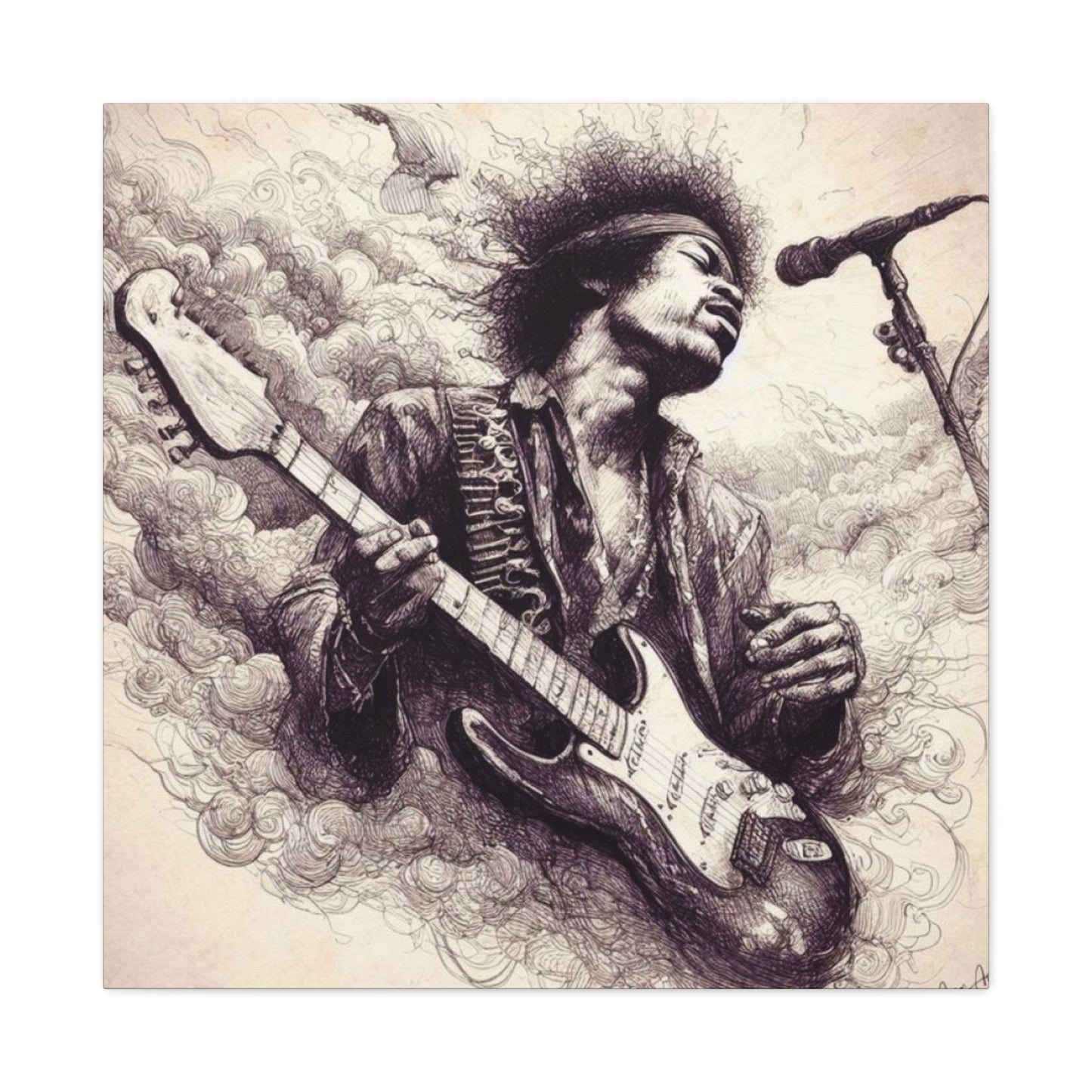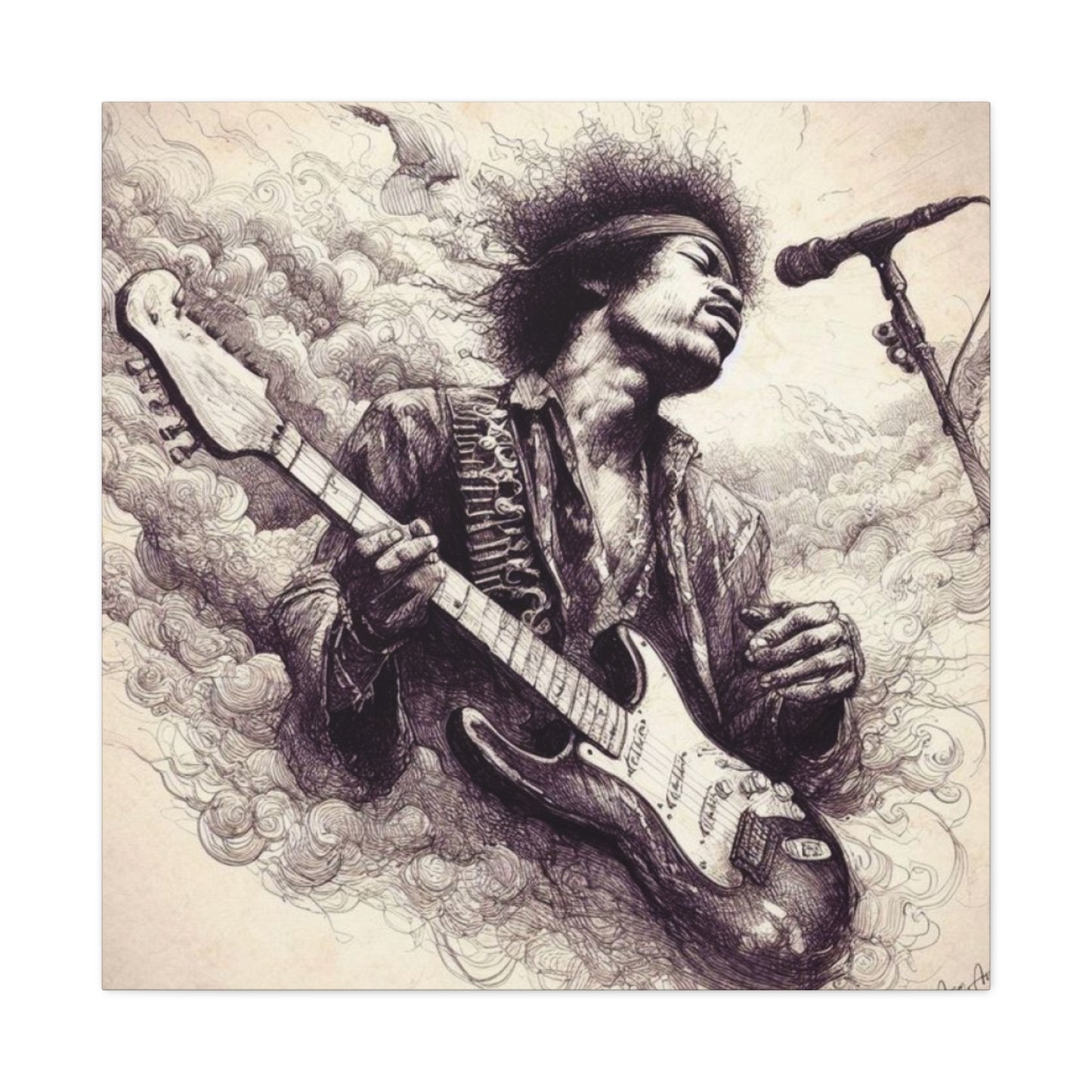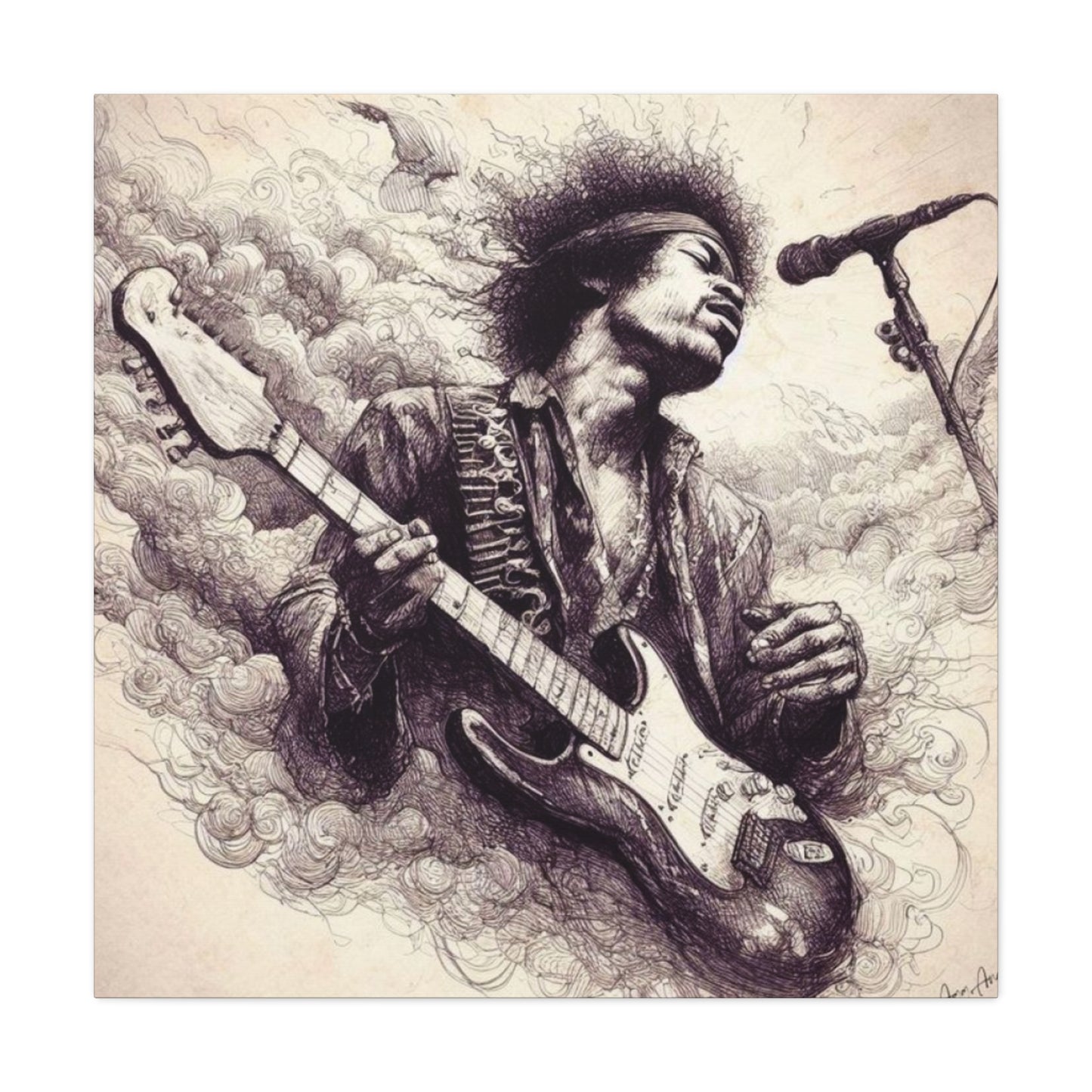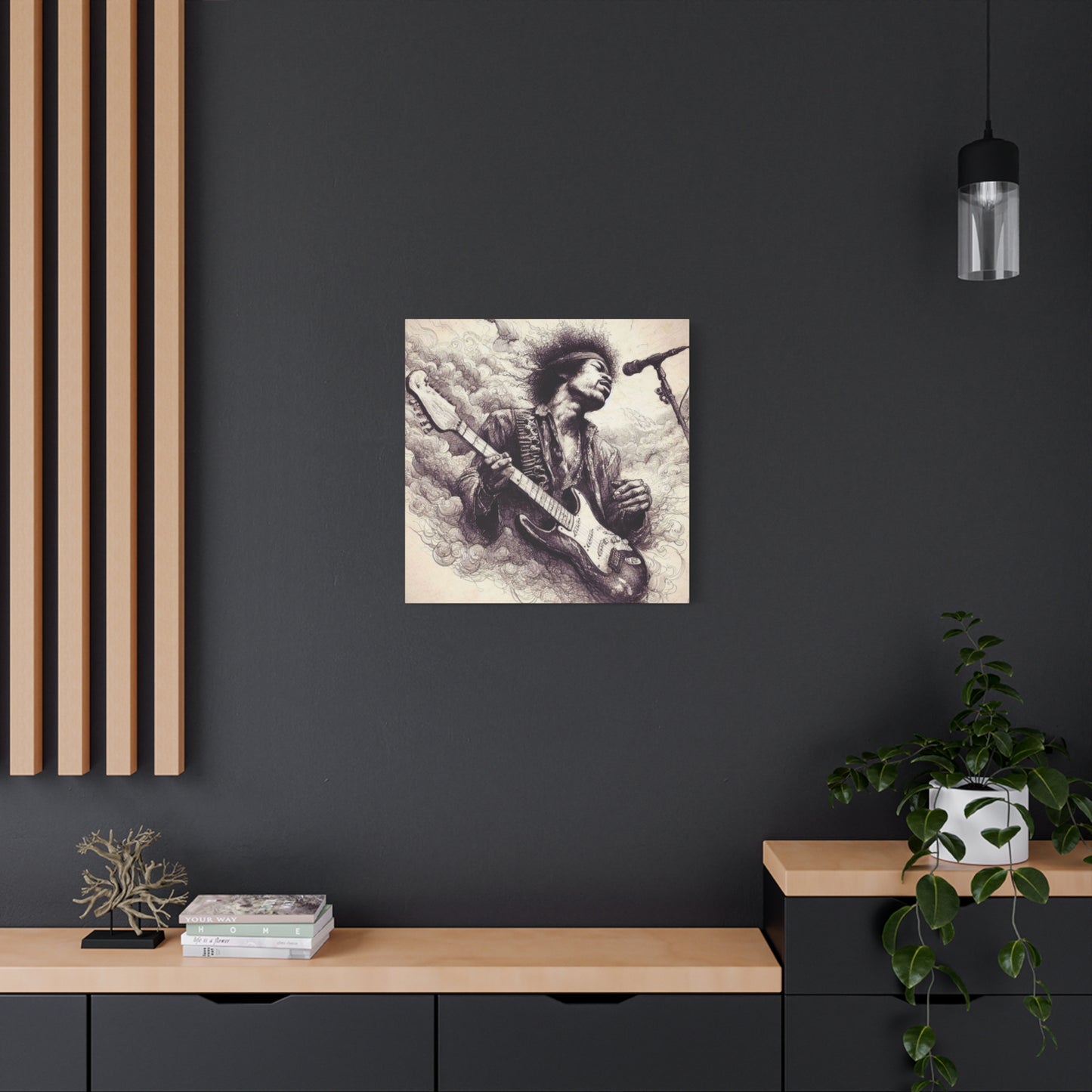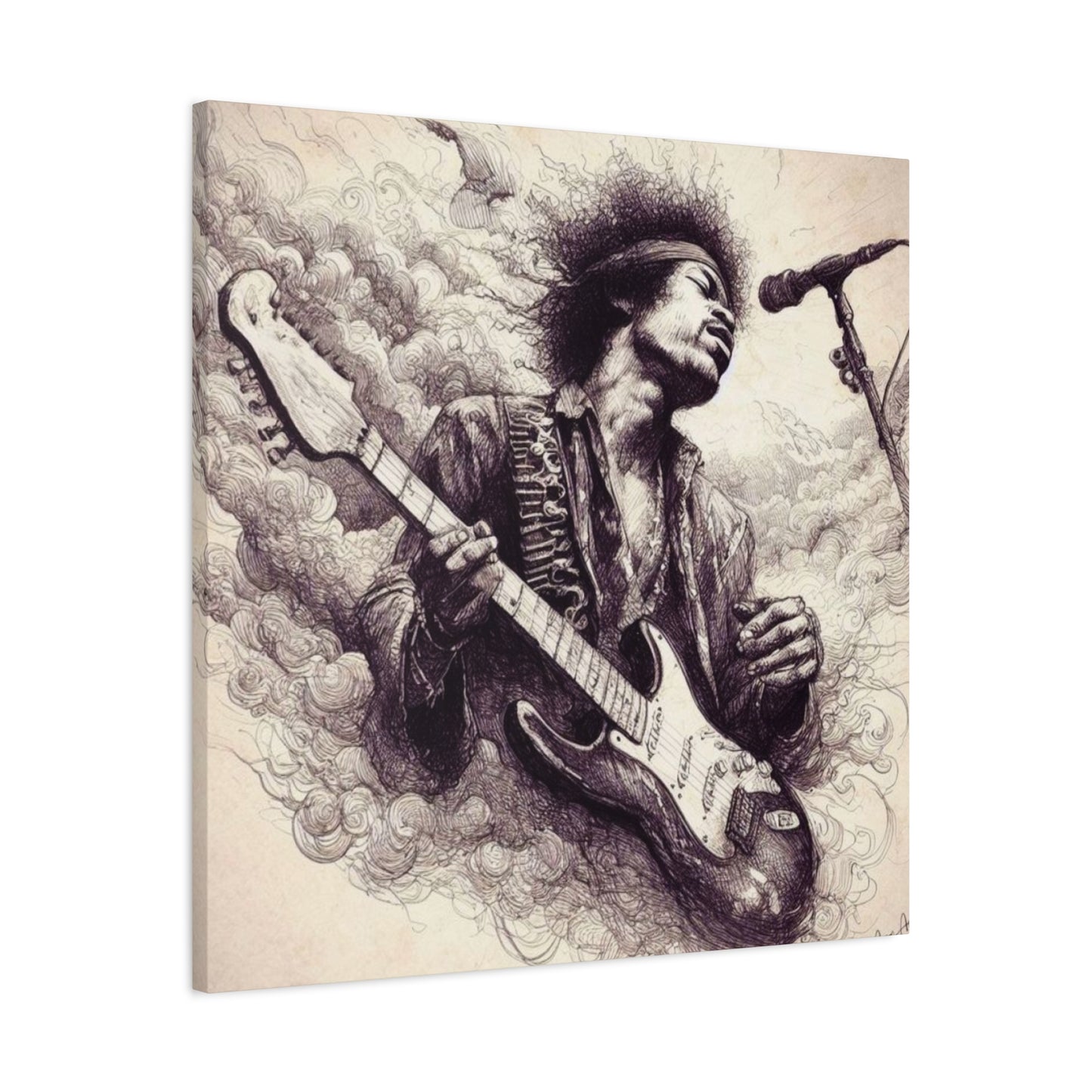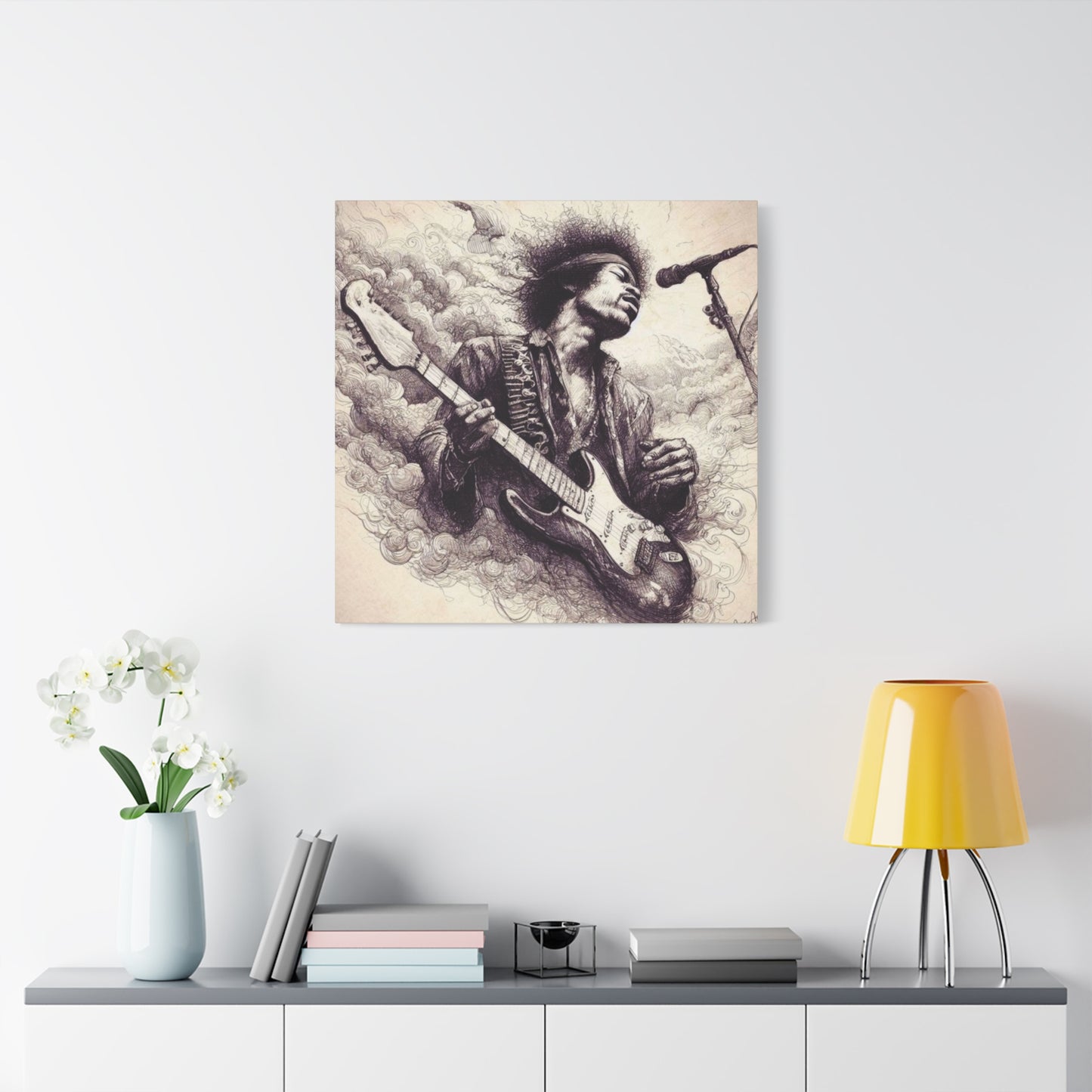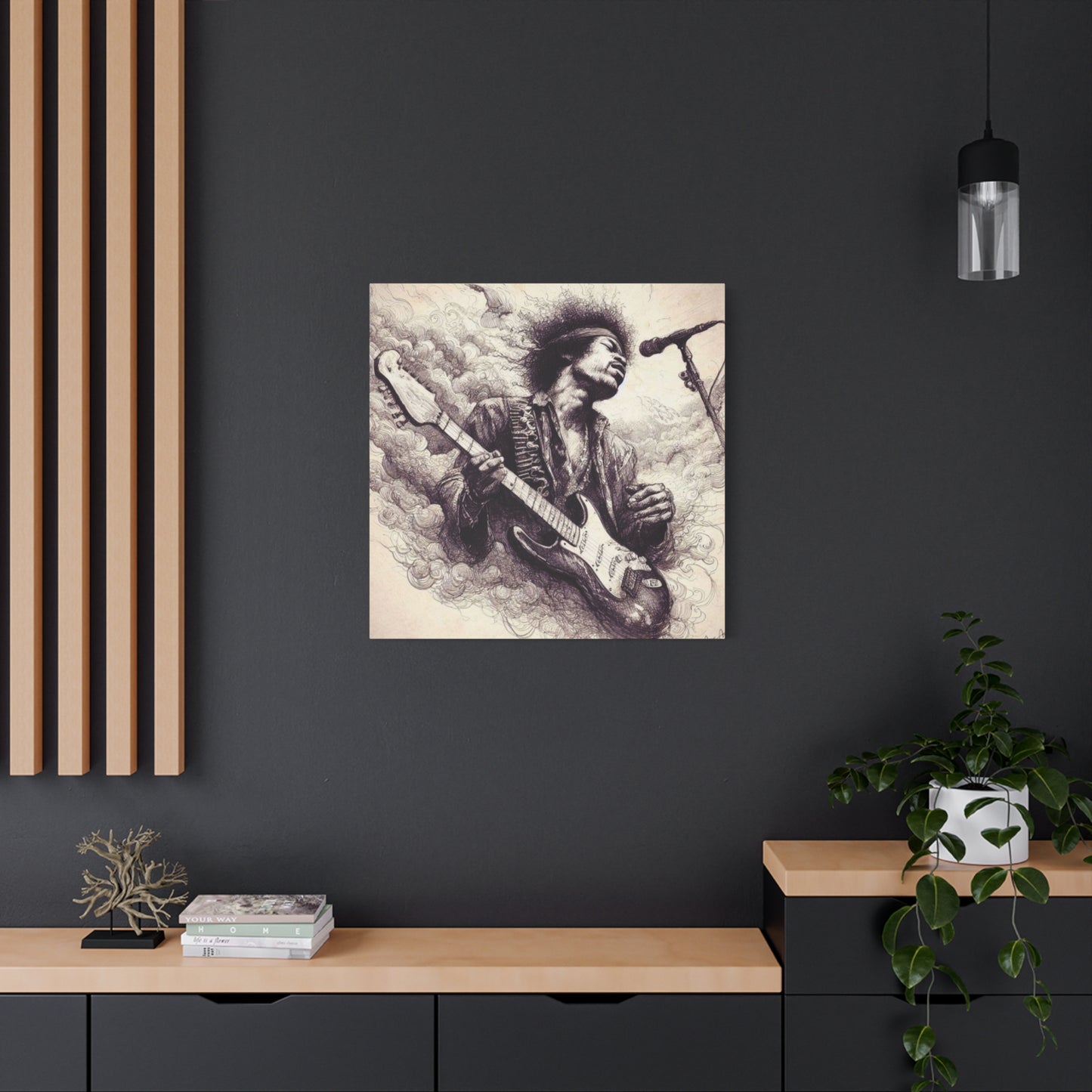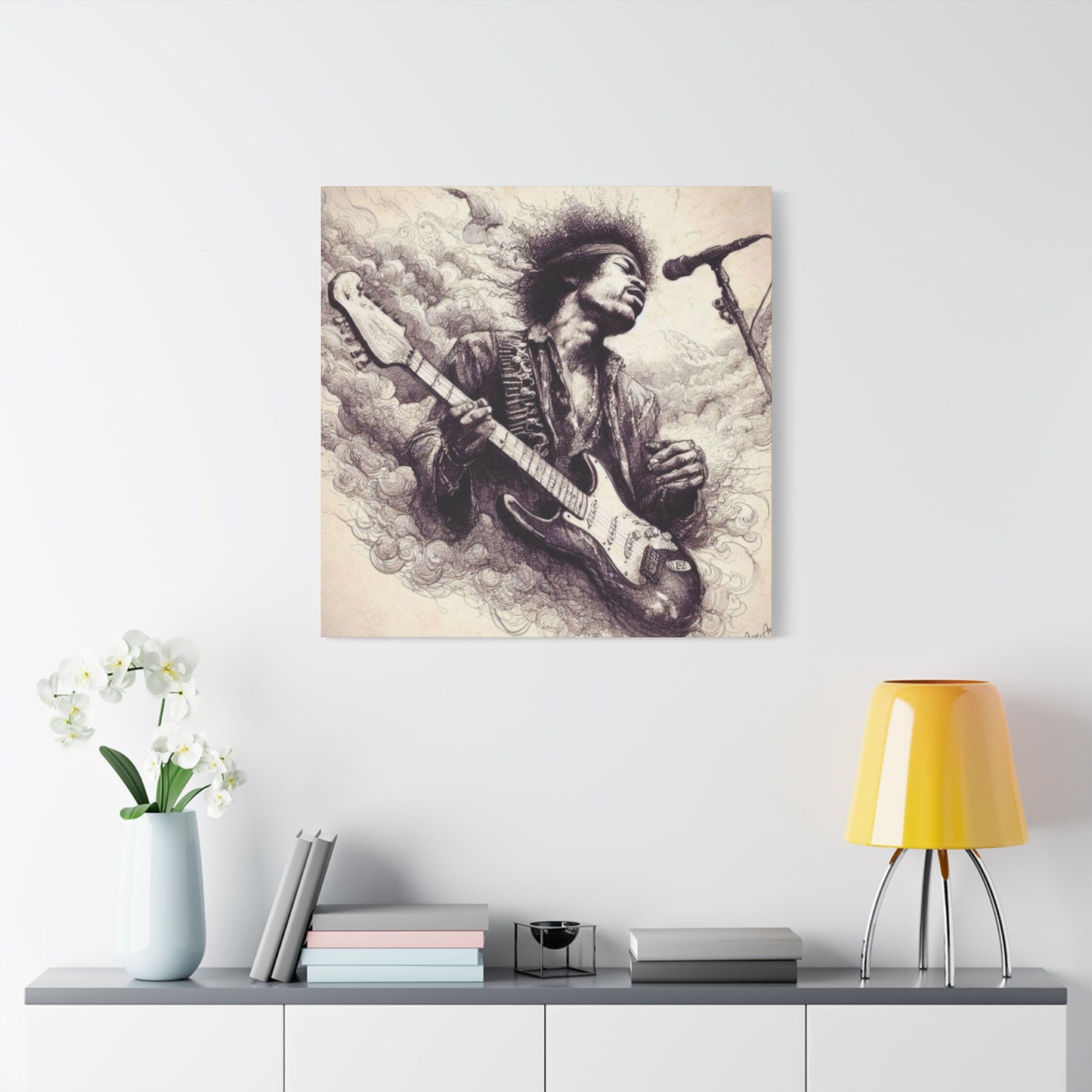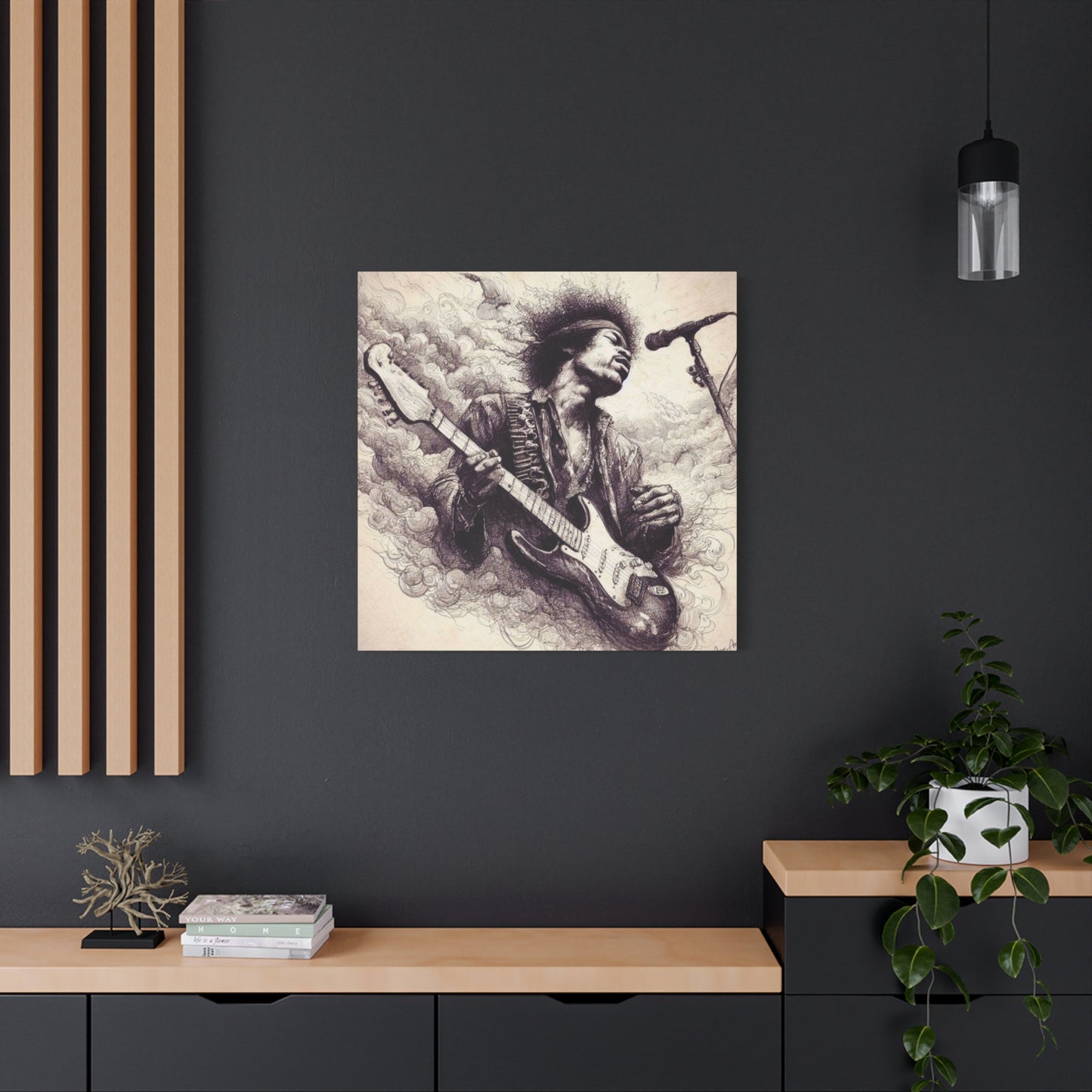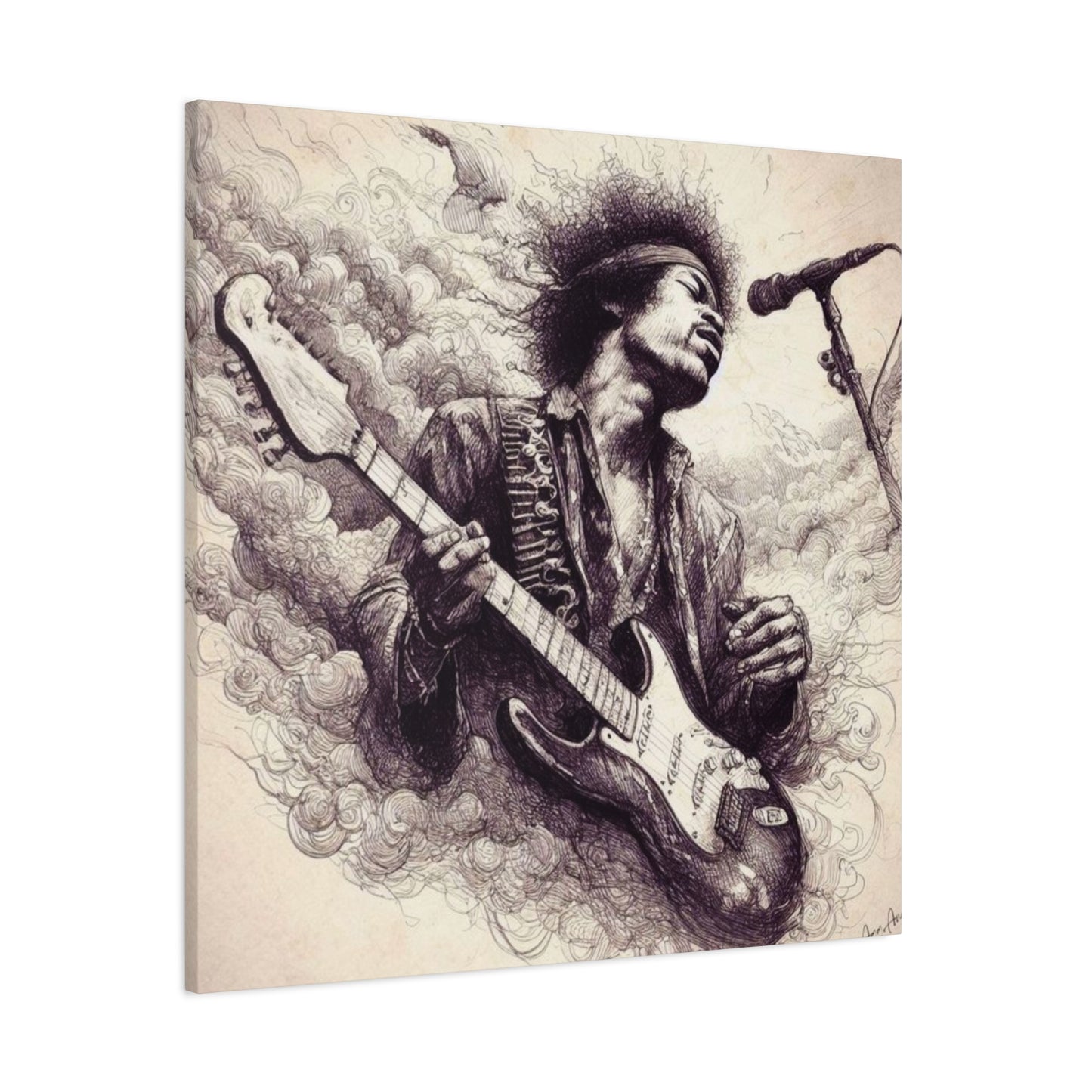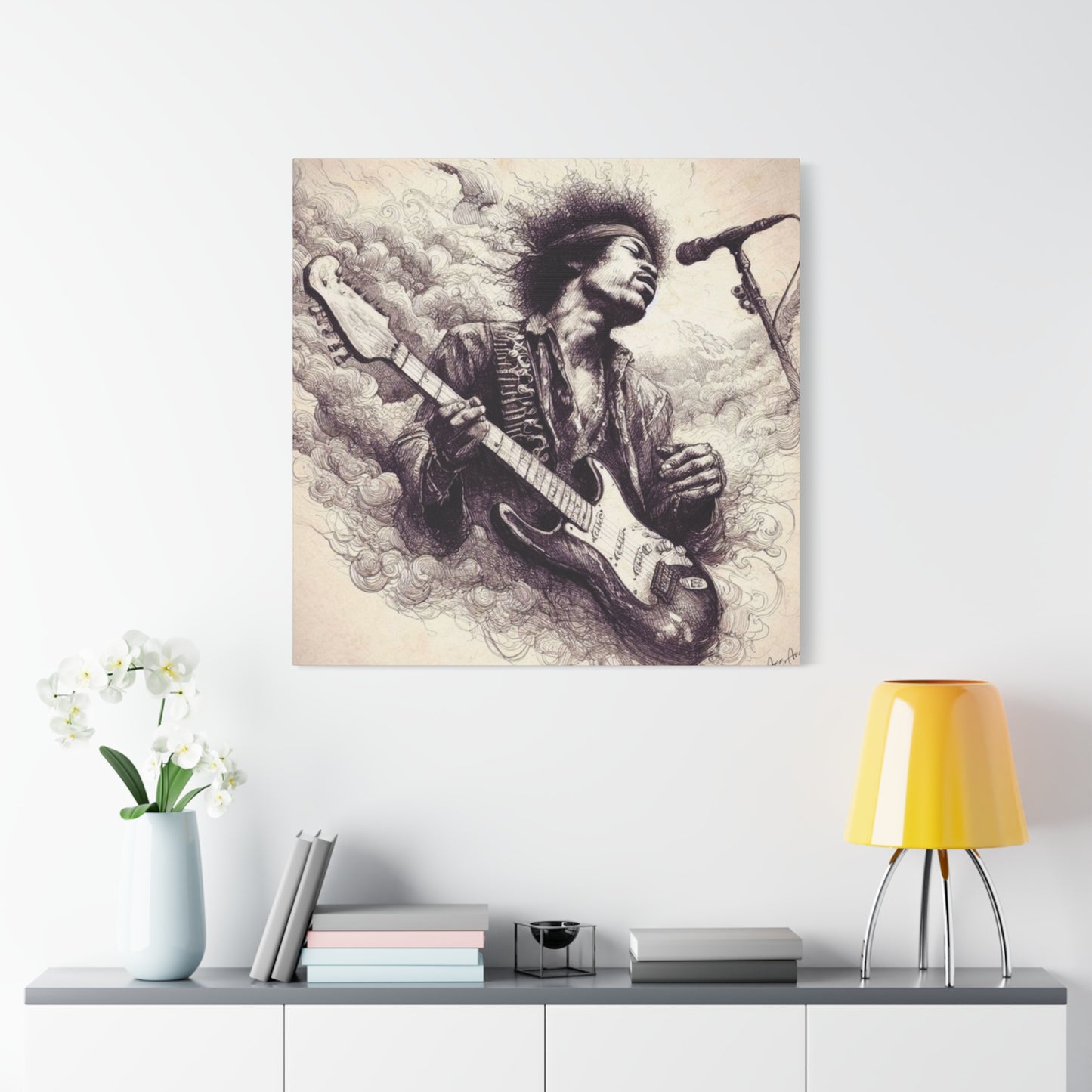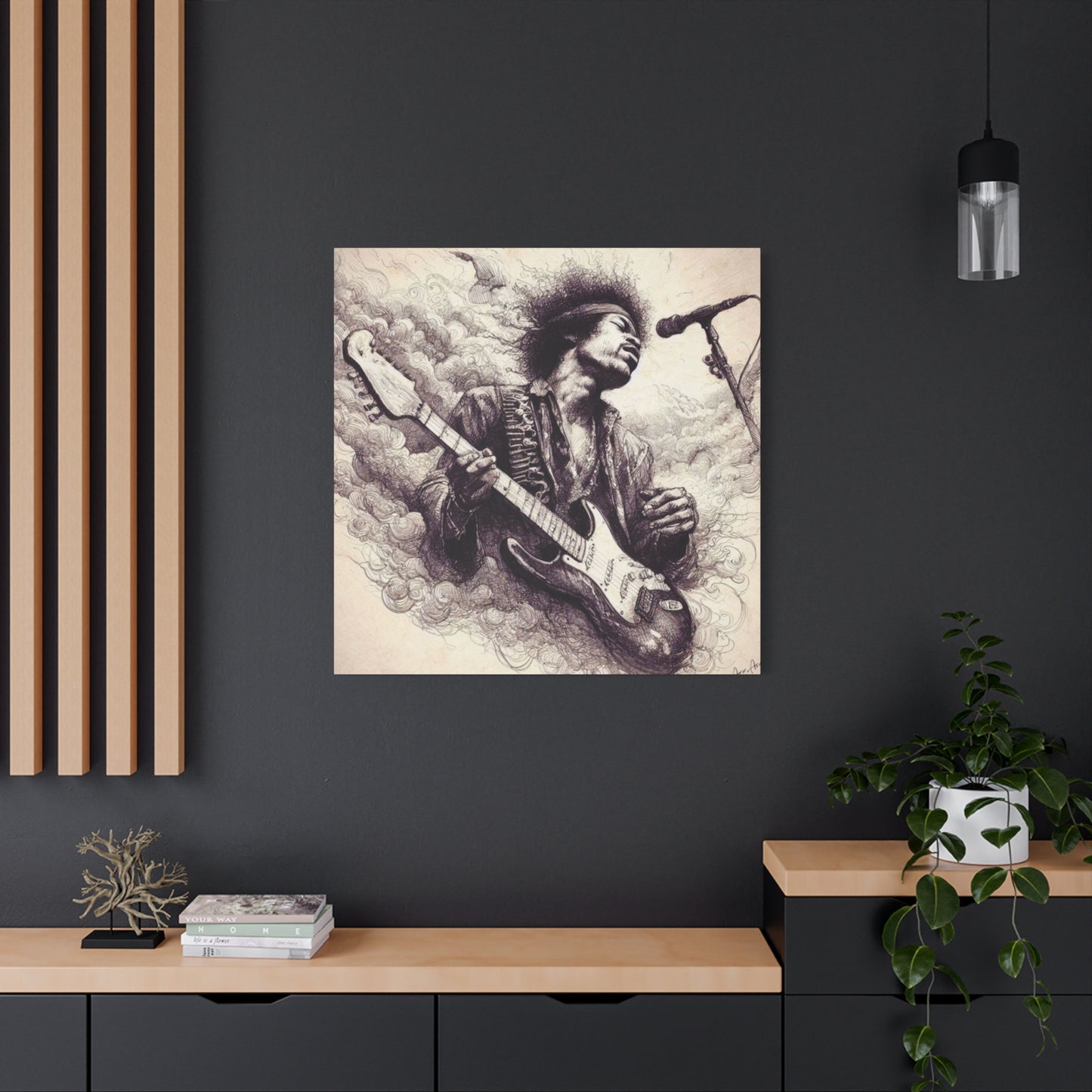Jimi Hendrix Guitar Wall Art: Elevating Your Space with Rock and Roll Legacy
The world of interior design has witnessed a remarkable fusion between music history and visual aesthetics, creating a unique niche that celebrates legendary musicians through captivating wall displays. Among the most sought-after pieces in this category are artistic representations featuring the extraordinary guitar work and persona of one of rock music's most influential figures. These decorative elements have transformed countless spaces, bringing the spirit of psychedelic rock and blues into homes, studios, and commercial establishments worldwide.
The appeal of guitar-themed wall decorations extends far beyond mere nostalgia. These pieces serve as powerful conversation starters, artistic statements, and cultural artifacts that commemorate the revolutionary impact of 1960s counterculture on modern society. When strategically placed in living areas, creative workspaces, or entertainment zones, these artworks create an atmosphere that resonates with energy, creativity, and the timeless appeal of rock and roll heritage.
Modern homeowners and interior designers increasingly recognize the value of incorporating music-inspired artwork into their decorating schemes. The visual representation of iconic guitar moments captures not just an instrument or a musician, but an entire era of cultural transformation, artistic innovation, and the breaking of musical boundaries. These pieces work exceptionally well in various settings, from minimalist contemporary apartments to eclectic bohemian lofts, demonstrating their versatility and enduring appeal.
The market for music-themed wall decorations has expanded significantly over recent years, offering consumers an impressive array of options in terms of size, color schemes, artistic styles, and price points. Whether someone seeks a subtle tribute to classic rock heritage or a bold centerpiece that dominates an entire wall, the available selection caters to diverse tastes and design preferences. This accessibility has democratized the ability to own museum-quality representations of rock and roll history.
Furthermore, these decorative pieces serve an educational purpose, introducing younger generations to the groundbreaking musical innovations that shaped contemporary sound. They represent more than aesthetic choices; they are tangible connections to a pivotal moment in cultural history when music transcended entertainment to become a vehicle for social change and artistic experimentation. The visual documentation of legendary guitar performances preserved in these artworks ensures that the legacy of revolutionary musicianship continues to inspire new audiences.
Rock Legend: Hendrix Guitar Prints
The category of legendary musician guitar prints represents one of the most dynamic segments within music memorabilia and decorative art markets. These specially designed pieces capture the essence of groundbreaking performances that redefined what was possible with six strings and an amplifier. The prints available today range from photographic reproductions of historic concert moments to abstract interpretations that emphasize the emotional and sonic qualities of revolutionary guitar playing.
What distinguishes high-quality guitar prints from standard posters is the attention to detail in capturing both the physical instrument and the intangible energy of performance. Professional photographers and artists who documented the golden age of rock and roll created visual records that go beyond simple documentation. They captured the intensity, passion, and innovative spirit that characterized performances during this transformative period in music history. These images preserve moments when musical boundaries were being shattered in real-time.
The production techniques used in creating contemporary guitar prints have evolved significantly with advances in printing technology. Modern giclée printing methods allow for museum-quality reproductions that maintain the color accuracy, contrast, and detail of original photographs or artwork. This technological advancement means that collectors can acquire prints that rival the quality of pieces found in prestigious music museums and galleries, making authentic representations accessible to a broader audience.
Collectors and decorators particularly value prints that capture specific iconic moments, such as performances at major music festivals, recording sessions, or candid backstage photographs that reveal the personality behind the public persona. These images provide intimate glimpses into the creative process and personal style of musicians who changed the course of popular music. The documentary nature of these prints adds historical significance to their aesthetic value.
The framing and presentation of guitar legend prints significantly impacts their visual effect and longevity. Professional framing with archival-quality materials protects the print from environmental damage while enhancing its presentation. Many collectors opt for custom framing solutions that complement both the artwork and their interior design scheme. The choice of mat colors, frame styles, and glass types can dramatically alter how a print integrates into its surrounding space.
Guitar prints also serve as excellent focal points in dedicated music rooms, home recording studios, or practice spaces. They create an inspirational atmosphere that encourages creativity and connects musicians to the rich heritage of their craft. Young guitarists often find motivation in visual reminders of the legendary performances that established new standards for technical proficiency and artistic expression. These prints become part of the creative environment that nurtures musical development.
Vintage Jimi Hendrix Poster Decor
Vintage poster aesthetics have experienced a remarkable renaissance in recent years as interior designers and homeowners rediscover the visual impact of retro graphic design. Original posters from the 1960s and 1970s featuring legendary musicians represent a specific artistic movement characterized by psychedelic imagery, bold typography, and vibrant color palettes that reflected the experimental spirit of the era. These design elements create immediate visual impact and transport viewers to a specific cultural moment.
Authentic vintage posters have become highly collectible items, with well-preserved examples commanding substantial prices at auction. Original concert promotion posters, particularly those from famous venues or historic performances, are considered valuable cultural artifacts. The rarity of these items stems from their original purpose as disposable promotional materials rather than permanent art pieces. Many were discarded after events concluded, making surviving examples increasingly scarce and valuable.
Contemporary reproductions of vintage poster designs allow enthusiasts to capture the aesthetic without the investment required for original pieces. High-quality reproductions faithfully recreate the printing techniques, color separations, and paper textures characteristic of original posters. Skilled reproduction houses use period-appropriate printing methods to achieve authenticity that satisfies both casual decorators and serious collectors. These reproductions make iconic imagery accessible while preserving the visual character of vintage design.
The distinctive visual language of vintage rock posters emerged from specific artistic movements, particularly the San Francisco poster art scene pioneered by designers working for legendary music venues. These artists developed a unique style combining Art Nouveau influences, comic book aesthetics, and psychedelic visual effects that mirrored the mind-expanding qualities of the music they promoted. The result was a graphic design revolution that influenced advertising, illustration, and fine art for decades.
Incorporating vintage poster aesthetics into modern interiors requires careful consideration of color coordination and placement. The bold, saturated colors typical of vintage designs can overwhelm spaces if not balanced with complementary elements. Interior designers often recommend using vintage posters as accent pieces within neutral color schemes, allowing the artwork to provide controlled bursts of color and visual interest. This approach prevents spaces from feeling dated while celebrating retro design elements.
The paper quality and printing methods used in original vintage posters contribute to their distinctive appearance and fragility. Original posters were typically printed on inexpensive paper stock using screen printing or offset lithography techniques. This combination results in characteristic visual qualities, including visible dot patterns, slight color variations, and paper aging that adds patina. Collectors prize these imperfections as markers of authenticity and age.
Preservation of vintage posters presents unique challenges due to the materials and conditions under which they were originally produced. Exposure to sunlight, humidity, and air pollutants can cause rapid deterioration of paper and inks. Professional conservators recommend climate-controlled display environments, UV-protective glazing, and acid-free mounting materials to extend the lifespan of valuable posters. Proper preservation ensures that these cultural artifacts remain viewable for future generations.
The cultural significance of vintage music posters extends beyond their function as promotional materials or decorative objects. They document the visual culture of a transformative period in popular music and social history. Museums increasingly recognize vintage rock posters as legitimate art forms worthy of preservation and scholarly study. Major exhibitions have explored the artistic merit and cultural impact of poster art from this era.
Iconic Guitar Moments in Art
The visual documentation of legendary guitar performances has produced some of the most recognizable images in popular culture. Photographers who captured musicians at the peak of creative expression created iconic photographs that transcend mere documentation to become standalone works of art. These images freeze moments of musical transcendence, preserving the physical gestures, facial expressions, and environmental contexts that made performances unforgettable.
Certain guitar moments have achieved such cultural significance that they have been reinterpreted countless times across various artistic mediums. Painters, illustrators, sculptors, and digital artists have all created works inspired by legendary performances, each bringing their unique perspective and technique to familiar subjects. This artistic dialogue between photography and other visual arts enriches our understanding of music's visual dimensions and demonstrates how single moments can inspire diverse creative responses.
The compositional elements that make guitar performance photographs artistically significant include lighting, framing, perspective, and timing. Masterful music photographers understand how to position themselves to capture the decisive moment when technical execution, emotional expression, and visual drama converge. The best performance photographs balance technical excellence with artistic vision, creating images that communicate the essence of musical experience to viewers who were not present at the original performance.
Art historians have begun examining legendary guitar photographs through the same critical lenses applied to traditional fine art. Academic analysis considers these images within broader contexts of performance art, cultural documentation, and portrait photography. This scholarly attention elevates music photography from commercial documentation to recognized artistic practice, validating the creative vision of photographers who documented rock and roll history.
The emotional resonance of iconic guitar moments stems partly from their ability to visualize sound. Great performance photographs somehow convey sonic qualities through purely visual means, suggesting the volume, tone, and energy of music that viewers cannot actually hear. This synesthetic quality makes these images particularly powerful for music enthusiasts, who can mentally reconstruct the sounds associated with visual representations of performance.
Limited edition fine art prints of iconic guitar moments represent a growing market segment where music memorabilia intersects with contemporary art collecting. Galleries specializing in music photography have emerged in major cultural centers, offering authenticated prints signed by photographers. These venues provide collectors with acquisition opportunities previously unavailable outside auction houses or direct relationships with photographers. The gallery system brings legitimacy and structure to the market for music photography.
Electric Vibes: Hendrix Canvas
Canvas prints have emerged as one of the most popular formats for displaying music-inspired artwork in residential and commercial settings. The texture and depth of canvas create a gallery-quality presentation that elevates images beyond what standard paper prints can achieve. Canvas wrapping around wooden stretcher bars produces a finished product that requires no additional framing, offering both aesthetic appeal and practical convenience for decorators.
The process of creating high-quality canvas prints involves sophisticated printing technology that ensures color accuracy and longevity. Professional canvas printing services use fade-resistant inks and archival-quality canvas materials designed to maintain their appearance for decades when properly displayed. The combination of durable substrates and modern printing technology produces artworks that can withstand the environmental conditions of typical indoor spaces without significant degradation.
Canvas prints excel at capturing the energy and movement characteristic of dynamic guitar performances. The slight texture of canvas adds visual interest and depth that enhances photographs of musicians in action. This textural quality creates subtle shadow patterns and light reflections that make images appear more dimensional than flat paper prints. The result is artwork that commands attention and creates visual interest from multiple viewing angles.
Size flexibility represents a significant advantage of canvas printing for large-scale wall displays. Canvas can be stretched across substantial dimensions without the structural concerns associated with framing large paper prints under glass. This capability allows decorators to create dramatic statement pieces that anchor entire room designs. Oversized canvas prints transform blank walls into focal points that establish the aesthetic character of spaces.
Multi-panel canvas arrangements, often called triptychs or polyptychs, offer creative composition options for displaying guitar imagery. Dividing a single image across multiple canvases creates visual rhythm and allows for flexible installation configurations. These segmented presentations work particularly well in contemporary interiors where clean lines and geometric precision complement modern furniture and architectural elements. The gaps between panels add abstract qualities to photographic imagery.
The lightweight nature of stretched canvas makes installation simpler than framed prints of comparable size. Most canvas prints come equipped with hanging hardware that allows for secure wall mounting without specialized tools or professional assistance. This ease of installation encourages more frequent rearrangement and experimentation with gallery wall configurations, giving homeowners flexibility to refresh their spaces without significant effort or expense.
Music Room Decor: Hendrix Guitar
Dedicated music rooms serve as creative sanctuaries where musicians practice, compose, and immerse themselves in their artistic craft. The decorative choices made in these spaces significantly impact the environment's inspirational qualities and functional effectiveness. Wall art featuring legendary guitarists creates an atmosphere that connects contemporary musicians with the rich heritage of their instrument and encourages creative exploration beyond conventional boundaries.
The acoustic properties of music rooms require special consideration when selecting wall decorations. Hard reflective surfaces can create undesirable sound reflections, while heavily textured materials may absorb specific frequencies unevenly. Canvas prints and framed posters generally have minimal impact on room acoustics, making them suitable choices for spaces where sound quality matters. More serious acoustic treatment typically addresses wall construction and dedicated sound absorption materials rather than decorative elements.
Organizing music room decor around specific themes or eras creates cohesive environments that immerse users in particular musical traditions. A room dedicated to classic rock heritage might feature extensive guitar-themed artwork from the 1960s and 1970s, creating a time-capsule atmosphere that celebrates that era's creative innovations. This thematic consistency strengthens the room's identity and creates a more powerful psychological impact on occupants.
Lighting design plays a crucial role in highlighting wall art within music rooms while providing adequate illumination for reading sheet music and operating equipment. Track lighting systems offer flexibility to direct light precisely onto artwork, creating gallery-style presentation while avoiding glare on instrument finishes or computer screens. Dimmable lighting allows users to adjust ambiance between focused practice sessions and relaxed listening experiences.
Music rooms in residential settings often serve multiple functions, including practice space, recording studio, and entertainment area. Decorative choices should accommodate this multifunctionality without compromising the room's primary purpose. Guitar-themed wall art provides consistent visual interest across these different uses while establishing the space's identity as dedicated to musical pursuits. The artwork remains relevant whether the room hosts solo practice or social gatherings.
Storage and display of musical instruments alongside themed wall art creates layered visual interest that celebrates both tools and traditions. Wall-mounted guitar hangers can be positioned to create compositional relationships with nearby artwork, treating instruments as sculptural elements within the overall design scheme. This integration of functional storage and decorative art maximizes wall space utilization while creating dynamic visual arrangements.
Bold Statement: Hendrix Wall Poster
Large-format wall posters create immediate visual impact that transforms spaces and establishes dominant aesthetic themes. The boldness of oversized imagery particularly suits open-concept living areas, creative studios, and commercial spaces where visual drama supports the environment's purpose. Poster-scale artwork demands attention and creates memorable impressions that smaller pieces cannot achieve, making them ideal for spaces designed to inspire or energize occupants and visitors.
The graphic design principles underlying effective large-format posters differ significantly from those governing smaller artworks. Bold imagery, high contrast, and simplified compositions work best at poster scale, where subtle details may be lost to viewing distance. Designers creating poster-scale artwork must consider how images will be perceived from across rooms rather than at intimate viewing distances. This requirement influences choices regarding color saturation, line weight, and compositional balance.
Modern printing technology has democratized access to large-format posters, making custom sizes and designs affordable for general consumers. Digital printing eliminates the setup costs and minimum order quantities that once restricted large-format printing to commercial applications. This accessibility encourages experimentation with scale and composition, allowing decorators to create custom solutions tailored to specific architectural features and spatial requirements.
Installation techniques for large posters range from simple poster putty to sophisticated mounting systems that provide clean, frameless presentation. Professional mounting on rigid backing materials creates gallery-quality displays that eliminate wrinkles and provide long-term durability. These investment-grade installation methods transform disposable posters into permanent architectural elements that contribute to property value and aesthetic appeal.
The temporary nature traditionally associated with posters has evolved as mounting and preservation techniques have improved. Contemporary decorators increasingly view large posters as legitimate decorative investments rather than temporary solutions. This shift reflects both improved production quality and changing attitudes about the relationship between fine art, commercial design, and interior decoration. The boundaries between these categories have become increasingly fluid.
Large-format posters excel in creating themed environments for commercial spaces like music venues, recording studios, and retail establishments catering to music enthusiasts. The cost-effectiveness of poster-scale artwork allows businesses to create immersive brand experiences without the investment required for custom murals or extensive art collections. Regular rotation of large posters enables businesses to refresh their visual identity and maintain customer interest over time.
Retro Rock Guitar Wall Prints
The aesthetic movement embracing retro design elements has profoundly influenced contemporary interior decoration, with music-themed artwork playing a central role in this nostalgic revival. Retro rock prints evoke specific historical periods through carefully chosen visual elements including color palettes, typography, photographic treatments, and compositional styles. These design choices create immediate temporal associations that transport viewers to earlier decades while remaining accessible and appealing to modern sensibilities.
Color theory plays a crucial role in establishing retro authenticity in rock-themed prints. The warm, slightly faded tones characteristic of aging paper and vintage photography processing distinguish genuine retro aesthetics from contemporary imagery. Designers creating retro-inspired prints carefully calibrate color temperatures, saturation levels, and tonal ranges to evoke specific eras. These technical choices communicate temporal context as effectively as subject matter itself.
Typography represents another critical element in retro rock print design. Font choices immediately signal specific decades, with psychedelic lettering styles suggesting late 1960s, bold sans-serif fonts indicating 1970s corporate rock, and punk-influenced hand-drawn typography evoking the late 1970s and early 1980s. Skilled designers select typefaces that authentically represent their chosen period while maintaining legibility and contemporary appeal.
The distressed or weathered appearance common in retro prints serves multiple purposes beyond nostalgic appeal. These visual treatments add textural interest and visual complexity to otherwise straightforward photographic imagery. The artificial aging process creates the impression that prints are vintage originals rather than contemporary reproductions, enhancing their perceived authenticity and historical connection. This visual strategy resonates with consumers seeking connections to cultural heritage.
Retro rock prints function effectively within eclectic design schemes that mix elements from multiple periods. The mid-century modern furniture revival has created ideal contexts for retro music artwork, as both design movements draw from similar historical periods and share aesthetic values. The synergy between vintage furniture design and retro rock imagery creates cohesive interiors that celebrate specific cultural moments without devolving into costume museum presentations.
The commercial success of retro aesthetics in fashion, graphic design, and product design has created cross-industry momentum that reinforces consumer appetite for vintage-inspired home decor. Music-themed wall art benefits from this broader cultural trend, riding waves of nostalgia that periodically revive interest in specific decades. Savvy retailers time their product releases to align with these cyclical nostalgia patterns, maximizing commercial success.
Authenticity debates surrounding retro reproductions versus genuine vintage items create interesting discussions within collecting communities. Some purists insist that only original pieces possess legitimate cultural value, while others embrace high-quality reproductions as acceptable alternatives that make iconic imagery accessible. This philosophical divide influences market dynamics, with clear price distinctions between authentic vintage items and contemporary reproductions.
Hendrix-Inspired Canvas Wall Art
Artistic interpretation of musical legends through canvas paintings and prints represents a creative intersection where fine art traditions meet popular culture. Artists working in this genre draw inspiration from biographical facts, legendary performances, and the visual iconography associated with revolutionary musicians. Their creative output ranges from photorealistic portraits to abstract compositions that attempt to visualize the emotional and sonic qualities of groundbreaking musical performances.
Contemporary artists creating music-inspired canvas works employ diverse techniques and styles, demonstrating that this subject matter accommodates multiple artistic approaches. Some painters work in hyperrealistic styles that capture minute details of instruments, clothing, and physical features. Others embrace expressionistic or abstract methods that prioritize emotional communication over literal representation. This stylistic diversity ensures that music-inspired canvas art appeals to collectors with varying aesthetic preferences.
The texture possibilities inherent in canvas painting add dimensional qualities absent from photographic prints. Impasto techniques creating raised paint surfaces, visible brushstrokes revealing artistic process, and layered glazes producing luminous depth all contribute to the unique visual character of painted canvas works. These textural elements engage viewers on sensory levels beyond pure visual perception, creating more immersive experiences than flat photographic reproductions.
Color choices in painted canvas works allow artists to interpret musical subjects through personal chromatic vocabularies. Rather than being constrained by photographic reality, painters can employ symbolic color systems that communicate mood, energy, or historical context. Vibrant, saturated palettes might suggest the psychedelic era's visual excesses, while muted, monochromatic schemes could evoke the documentary authenticity of black-and-white photography.
Mixed media techniques incorporating collage elements, found objects, or digital components expand the expressive possibilities of music-themed canvas art. These hybrid approaches reflect contemporary art practices that freely combine materials and methods from different traditions. The resulting works possess layered meanings and visual complexity that reward sustained viewing and interpretation, elevating them beyond simple decorative objects.
The art market for original music-themed paintings has grown substantially as collectors recognize these works as legitimate contemporary art rather than mere commercial illustration. Galleries representing artists specializing in music subjects have emerged in cultural centers worldwide, providing exhibition opportunities and market access. This institutional support has elevated the status of music-inspired art while creating career opportunities for talented artists working in this niche.
Bedroom Decor for Music Lovers
Personal bedrooms represent intimate spaces where individual identity finds full expression through decorative choices unencumbered by considerations of guest appeal or family consensus. Music enthusiasts often prioritize their bedrooms as locations to display their passion through carefully curated wall art, memorabilia collections, and thematic decorating schemes. These personal sanctuaries become reflections of musical identity and artistic values that provide daily inspiration and comfort.
The psychology of bedroom decoration emphasizes creating environments that support rest, relaxation, and emotional wellbeing. Music-themed artwork contributes to these goals by surrounding occupants with imagery that evokes positive associations and personal meaning. For devoted music fans, representations of favorite artists and iconic performances create reassuring familiarity and connection to broader cultural communities, combating feelings of isolation and alienation.
Scale considerations in bedroom decor differ from those governing public spaces, as bedrooms typically offer more intimate viewing distances and smaller wall expanses. Medium-sized prints often prove more suitable than oversized statement pieces, creating visual interest without overwhelming limited square footage. Careful placement relative to furniture arrangements ensures that artwork remains visible and appreciated rather than hidden behind beds or blocked by dressers.
Gallery wall arrangements represent popular solutions for displaying multiple music-themed pieces within bedrooms. These curated collections allow enthusiasts to showcase diverse aspects of their musical interests while creating unified visual statements. Successful gallery walls balance variety with cohesion, typically employing consistent framing styles or color schemes to unify disparate images. The personalization potential of gallery walls makes them particularly appealing for expressing complex musical identities.
Lighting design in bedrooms must accommodate multiple activities including sleeping, reading, and relaxing while highlighting decorative artwork. Adjustable lighting systems allow occupants to create different atmospheres appropriate to various moods and times of day. Accent lighting directed at music-themed wall art creates gallery-style presentation during evening hours while avoiding sleep-disrupting brightness during nighttime hours.
The integration of music playback systems with bedroom decor creates multisensory environments where visual and auditory elements reinforce each other. Positioning speakers near artwork featuring the performed artists creates experiential coherence that enhances appreciation of both music and visual art. This thoughtful integration demonstrates sophisticated understanding of how multiple sensory inputs combine to shape environmental experience.
Teenage bedrooms particularly benefit from music-themed decoration that validates emerging identities and provides vehicles for self-expression. Parents encouraging age-appropriate personalization foster healthy identity development and create spaces where teenagers feel comfortable and understood. Music-themed wall art offers relatively safe rebellion, allowing youth to express individuality and countercultural leanings without permanent consequences or dangerous behaviors.
Artistic Tribute: Jimi Hendrix Guitar
Artistic tributes to legendary musicians serve important cultural functions beyond their decorative purposes. These works preserve and celebrate artistic achievements that might otherwise fade from collective memory as generations pass. Visual artists creating tributes engage in cultural preservation work, translating musical achievements into permanent visual forms that communicate across temporal and cultural boundaries. Their efforts ensure that revolutionary artistic contributions remain accessible to audiences who never experienced original performances.
The creative challenge inherent in visual tributes to musicians involves translating auditory experiences into purely visual languages. Artists must find visual equivalents for sonic qualities, capturing the essence of guitar tones, rhythmic patterns, and melodic structures through color, composition, and form. This synesthetic translation requires both deep musical understanding and sophisticated visual artistry, making successful examples particularly impressive achievements.
Stylistic diversity in artistic tributes reflects the multifaceted nature of legendary musicians' legacies. Abstract works might emphasize the emotional or spiritual dimensions of musical experience, while realistic portraits focus on physical presence and personality. Each stylistic approach illuminates different aspects of complex artistic personalities, contributing to comprehensive understanding that no single work could achieve. Collectively, diverse tributes create rich visual discourses around musical subjects.
The relationship between commercial and fine art traditions in music-themed artwork creates interesting tensions and opportunities. Images originally created for commercial purposes like album covers or concert promotions have achieved fine art status through cultural significance and visual excellence. This elevation demonstrates how contextual factors and historical importance can transform commercial objects into respected artworks worthy of museum preservation and scholarly attention.
Contemporary artists creating tributes benefit from extensive photographic and video documentation that provides source material unavailable for earlier historical figures. This archival wealth allows for informed interpretations grounded in actual visual records rather than imagination or secondary descriptions. However, the abundance of reference material also creates challenges, as artists must find fresh perspectives on extensively documented subjects to avoid redundancy.
The commemorative function of artistic tributes becomes particularly significant following artists' deaths, when new creative output ceases and preservation of legacy becomes urgent. Visual artists contribute to posthumous reputation management through their choices of which moments, qualities, or achievements to emphasize. These selective interpretations influence how future generations understand and value musical legacies, making tribute artists active participants in historical narrative construction.
Educational institutions and cultural organizations commission artistic tributes for permanent installations that honor local connections to musical legends. These public artworks serve civic functions, creating points of cultural pride and tourist interest while educating residents and visitors about regional contributions to music history. The permanent, accessible nature of these installations democratizes cultural education beyond traditional museum contexts.
Living Room Rock Wall Designs
Living rooms occupy central positions within homes, serving as primary gathering spaces for family activities and guest entertainment. Decorative choices in these public areas require balancing personal expression with broader appeal, creating environments that feel welcoming to diverse visitors while reflecting homeowners' identities and values. Rock-themed wall designs strike effective balances between personal passion and universal accessibility, as music appreciation transcends demographic boundaries.
The architectural features of living rooms significantly influence wall design possibilities and constraints. Focal point walls, typically those most visible from entry points or featuring fireplaces and entertainment centers, demand special design attention. Rock-themed artwork positioned on these prominent walls establishes immediate aesthetic tone and signals homeowners' cultural interests to visitors. Strategic placement transforms generic spaces into personalized environments with distinct character.
Color coordination between rock-themed artwork and existing living room palettes requires careful planning to achieve cohesive results. The bold colors often present in music imagery must either complement or intentionally contrast with wall colors, furniture upholstery, and decorative accessories. Interior designers employ various strategies including extracting accent colors from artwork to inform accessory choices or using neutral backgrounds to allow colorful music prints to provide controlled color bursts.
Scale relationships between furniture, architectural elements, and wall art determine visual balance within living rooms. Oversized artwork can anchor large walls above sofas or entertainment centers, while smaller pieces may feel lost in expansive spaces. Professional designers often recommend that artwork above sofas span two-thirds to three-quarters of the furniture's width, creating proportional relationships that feel intentional rather than arbitrary.
The layering technique employed in sophisticated living room designs incorporates wall art within broader decorative schemes including furniture, lighting, textiles, and accessories. Rock-themed prints become elements within complex visual compositions rather than isolated focal points. This integrated approach creates cohesive environments where multiple components work together to establish unified aesthetic identities. The artwork contributes to rather than dominates overall design schemes.
Affordable Hendrix Poster Prints
Economic accessibility represents a crucial factor enabling widespread participation in music-themed home decoration. Affordable poster prints democratize access to iconic imagery that might otherwise remain exclusive to wealthy collectors of original photographs or limited edition fine art prints. This accessibility supports cultural education and allows enthusiasts across socioeconomic spectrums to surround themselves with inspirational imagery that connects them to music history.
The print-on-demand business model has revolutionized the poster market by eliminating inventory costs and minimum order quantities that previously restricted affordable options. Digital marketplaces connect independent artists and commercial printers with global customer bases, creating efficient distribution systems that reduce costs while expanding selection. This technological transformation has fundamentally altered the economics of poster production and distribution.
Quality variations within affordable poster categories require educated purchasing decisions. Budget-conscious consumers must balance price considerations against factors including paper quality, printing resolution, color accuracy, and customer service reliability. Online reviews and comparison shopping help identify reputable vendors offering genuine value rather than false economy through inferior products that disappoint upon delivery or deteriorate rapidly after display.
Standard poster sizes offer cost advantages through efficient paper utilization and compatibility with readily available frames. Common dimensions including eighteen by twenty-four inches and twenty-four by thirty-six inches allow printers to optimize material usage and maintain inventory of complementary framing products. Consumers ordering standard sizes benefit from these efficiencies through lower prices and faster production times compared to custom dimensions.
Bulk purchasing discounts and promotional sales provide opportunities for significant savings on poster acquisitions. Retailers periodically offer percentage discounts, buy-one-get-one promotions, or free shipping incentives that dramatically reduce per-unit costs. Patient shoppers monitoring multiple vendors can accumulate collections at fraction of retail prices by strategically timing purchases around predictable promotional cycles.
The distinction between affordable commercial prints and artist-signed limited editions involves more than price differences. Limited editions typically include certificates of authenticity, higher-quality printing methods, archival materials, and artist signatures that enhance collectible value. These premium features justify higher prices for serious collectors while affordable commercial prints serve decorative needs at accessible price points.
Colorful Guitar Canvas Wall Art
Color psychology plays a fundamental role in how visual artwork impacts viewers' emotional states and environmental perceptions. Colorful guitar-themed canvas art harnesses chromatic intensity to create energizing, mood-lifting effects that transform spaces from neutral backgrounds into vibrant environments. The bold color palettes often associated with rock and roll imagery amplify the music's inherent energy, translating sonic intensity into visual equivalents that engage viewers on visceral levels.
The technical challenges of reproducing vibrant colors accurately in canvas prints require sophisticated printing technology and careful color management. Professional print services employ wide-gamut ink systems capable of producing saturated colors that match or exceed the intensity of original photographs or digital artwork. Color calibration between digital files, computer monitors, and printing equipment ensures that final products faithfully represent artists' intentions and meet customers' expectations.
Abstract and interpretive approaches to guitar imagery often employ color as primary expressive elements rather than merely documenting reality. Artists working in these styles use color symbolically, associating specific hues with emotional qualities, musical genres, or historical periods. Psychedelic color combinations might evoke experimental music eras, while monochromatic schemes could suggest blues traditions' emotional depth. These symbolic color applications add layers of meaning beyond literal representation.
Hendrix Guitar Poster for Studios
Recording studios, rehearsal spaces, and professional music facilities require specialized decorative approaches that balance aesthetic appeal with functional requirements. Guitar-themed posters in these environments serve multiple purposes including inspiration, client impression management, and reinforcement of facility identity. The decorative choices made in professional music spaces communicate values, expertise, and cultural positioning to musicians who use these facilities.
Acoustic considerations influence poster selection and placement in professional music environments. While posters themselves have minimal acoustic impact, their placement must not interfere with strategically positioned sound absorption panels, bass traps, or diffusion elements. Studio designers integrate decorative artwork within comprehensive acoustic treatment plans, ensuring that visual and sonic environmental qualities both meet professional standards.
Client psychology represents an important consideration in studio decoration decisions. Musicians evaluating potential recording facilities form impressions based partly on visual environments that suggest technical competence and cultural understanding. Guitar-themed posters featuring legendary musicians communicate facility owners' appreciation for music history and implied connection to professional excellence, creating positive associations that influence booking decisions.
The inspirational function of music-themed artwork in professional studios directly impacts creative productivity. Musicians spending extended hours in recording environments benefit psychologically from visual reminders of artistic excellence and cultural significance of their work. Posters featuring legendary performances can provide motivation during challenging sessions and remind artists of the broader traditions within which they work.
Branding opportunities through curated poster selections allow studios to establish distinctive identities within competitive markets. A studio specializing in blues music might emphasize related imagery, while facilities focused on experimental music could showcase more avant-garde visual aesthetics. This thematic consistency strengthens brand identity and helps facilities attract ideal clientele whose artistic sensibilities align with the studio's cultural positioning.
Classic Rock-Inspired Wall Decor
The enduring appeal of classic rock aesthetics in contemporary interior design reflects broader cultural nostalgia for perceived golden ages of artistic authenticity and cultural vitality. Classic rock-inspired wall decor taps into collective memories and inherited cultural narratives celebrating a period when popular music achieved unprecedented artistic and social significance. These decorative choices represent more than style preferences; they constitute statements about values, authenticity, and resistance to disposable contemporary culture.
The definition of classic rock as a distinct genre and era involves both musical and cultural parameters. Generally encompassing music from the mid-1960s through early 1980s, classic rock represents a period of extraordinary musical innovation, album-oriented creativity, and guitar-centered composition. Wall decor emphasizing this era celebrates specific aesthetic values including instrumental virtuosity, songwriting craft, and conceptual ambition that distinguished classic rock from subsequent popular music developments.
Material authenticity in classic rock-inspired decor manifests through printing techniques, paper selections, and finishing methods that evoke period production values. Distressed finishes, warm color temperatures, and visible printing artifacts create impressions of vintage authenticity even in contemporary reproductions. These design choices satisfy consumer desires for connections to perceived authentic cultural moments without requiring expensive original vintage items.
The integration of classic rock imagery within mid-century modern or vintage-inspired interior designs creates temporal coherence that strengthens overall aesthetic statements. Furniture, lighting, and architectural elements from the classic rock era complement music-themed wall decor, producing immersive environments that transport occupants to specific historical periods. This comprehensive approach to period design demonstrates sophisticated understanding of how multiple environmental elements combine to create convincing atmospheric effects.
Gender dynamics in classic rock imagery reflect the male-dominated nature of 1960s and 1970s rock music, presenting challenges for decorators seeking inclusive environments. The predominance of male musicians in classic rock visual archives can create unintentionally exclusionary atmospheres. Thoughtful decorators address this imbalance by incorporating female artists who contributed to rock history or by balancing music imagery with other decorative elements that provide gender diversity.
The educational value of classic rock-inspired decor extends to younger generations who may lack direct experience with this music's cultural impact. Parents and educators use classic rock imagery as conversation starters about social history, technological change, and artistic evolution. These visual references to music history support intergenerational dialogue and cultural transmission that might not occur without environmental prompts.
Commercial applications of classic rock aesthetics in restaurants, bars, and retail establishments leverage the broad demographic appeal of this imagery. Businesses targeting baby boomer and Generation X consumers particularly benefit from classic rock themes that evoke customers' youth and create comfortable, familiar atmospheres. The nostalgic comfort provided by these environments encourages extended visits and repeat patronage.
The relationship between classic rock aesthetics and contemporary music production creates interesting tensions for decorators balancing historical appreciation with current relevance. Some enthusiasts view classic rock imagery as celebrating superior past achievements while implicitly critiquing contemporary music's perceived shortcomings. Others integrate classic and contemporary imagery to demonstrate continuity and evolution rather than decline, presenting more optimistic narratives about musical development.
Legendary Guitarist: Hendrix on Canvas
The elevation of individual musicians to legendary status involves complex processes of critical consensus, commercial success, cultural impact, and biographical narrative construction. Visual representations of legendary guitarists participate in these reputation-building processes by providing iconic images that become inseparable from musical legacies. Canvas artwork featuring these musicians reinforces their legendary status while making abstract reputations tangible through specific visual references.
The criteria distinguishing legendary musicians from merely successful ones include technical innovation, stylistic influence, cultural significance, and enduring relevance across generations. Legendary guitarists fundamentally altered their instrument's expressive possibilities and influenced countless subsequent musicians. Visual artwork celebrating these figures emphasizes innovative techniques, signature instruments, and iconic performance moments that illustrate their groundbreaking contributions.
Biographical narratives embedded in visual representations of legendary musicians emphasize dramatic life events, struggles overcome, and artistic dedication. Canvas artwork often references specific career milestones, famous performances, or symbolic moments that crystallize broader life stories. These narrative elements transform individual images into visual summaries of complex biographies, allowing single artworks to communicate extensive information to knowledgeable viewers.
The commercial market for legendary musician artwork reflects sustained public interest that transcends generational boundaries. While original fans age, new audiences continually discover classic music through various media channels, maintaining demand for related visual memorabilia. This intergenerational appeal makes legendary guitarist imagery relatively safe investment choices compared to contemporary artists whose long-term cultural relevance remains uncertain.
Authentication challenges surrounding valuable canvas artwork featuring legendary musicians require expert knowledge and documentation. The proliferation of unauthorized reproductions and counterfeit memorabilia necessitates careful provenance research before significant purchases. Collectors rely on authentication services, gallery reputations, and documented chains of custody to verify legitimacy and protect investments.
The hagiographic tendency in legendary musician representations creates idealized images that sometimes conflict with complex biographical realities. Visual artwork typically emphasizes artistic achievements while minimizing personal flaws, controversial behaviors, or troubled aspects of musicians' lives. This selective representation serves legitimate purposes of celebration while potentially obscuring fuller historical understanding.
Museum exhibitions featuring legendary guitarist artifacts and imagery validate their cultural significance and educational value. Major institutions mounting comprehensive exhibitions treat music history with seriousness previously reserved for traditional fine arts. These institutional endorsements influence market values for related artwork while shaping public understanding of musicians' historical importance.
Contemporary Jimi Hendrix Art Ideas
Contemporary artistic engagement with legendary musicians involves reinterpretation through current aesthetic sensibilities, techniques, and cultural contexts. Modern artists creating work inspired by classic rock figures balance respect for historical subjects with desire for fresh perspectives that speak to contemporary audiences. This creative tension produces innovative artworks that honor musical legacies while asserting their own artistic merit and relevance.
Digital art techniques enable visual effects and compositional approaches impossible with traditional media. Contemporary artists employ photo manipulation, digital painting, 3D rendering, and generative algorithms to create music-inspired artwork with unprecedented complexity and visual impact. These technological tools expand artistic possibilities while raising questions about definitions of originality and artistic authenticity in digital age.
Street art and graffiti aesthetics have profoundly influenced contemporary approaches to music-themed artwork. Urban artists incorporate spray paint techniques, stenciling, and text-based elements drawn from street art traditions into gallery-bound works. This cross-pollination between high and low art contexts reflects broader democratization of artistic production and challenges traditional hierarchies distinguishing legitimate art from commercial design.
The appropriation art movement's influence appears in contemporary works that sample, remix, and recontextualize existing music imagery. Artists working in this tradition create derivative works that comment on original sources while asserting independent artistic value. Legal and ethical questions surrounding appropriation create productive tensions that force consideration of authorship, originality, and artistic property in remix culture era.
Minimalist approaches to music-themed artwork reduce subjects to essential visual elements, creating elegant simplifications that communicate through economy rather than elaboration. Contemporary minimalist artists might represent legendary guitarists through single iconic instruments, characteristic silhouettes, or abstract color fields that evoke rather than depict. These reductive strategies create sophisticated artworks that reward viewers capable of decoding cultural references.
Installation art approaches transform music-themed artwork from wall-mounted objects into immersive environmental experiences. Contemporary artists create multi-sensory installations incorporating sound, light, projection, and physical objects that surround viewers. These experiential artworks engage audiences more actively than traditional static images, creating memorable experiences that deepen connections to musical subjects.
Social media platforms have become important exhibition venues for contemporary music-themed artwork, enabling global audiences and viral distribution. Artists build followings through strategic platform use, releasing work directly to public audiences without gallery intermediation. This direct distribution model challenges traditional art world gatekeeping while creating new challenges around monetization and intellectual property protection.
Collaborative projects between visual artists and musicians produce contemporary works that integrate multiple creative disciplines. These partnerships might involve live painting during musical performances, animated visual accompaniments to recordings, or jointly conceived multimedia projects. The resulting works demonstrate how music and visual art can enhance each other through thoughtful integration.
Environmental and sustainability concerns influence contemporary artists' material choices and conceptual approaches. Some contemporary creators emphasize recycled materials, low-impact production methods, or themes addressing ecological crisis. Music-themed artwork incorporating these environmental considerations connects rock and roll's countercultural legacy to contemporary activism around climate and sustainability.
Conclusion
The enduring fascination with guitar-themed wall art, particularly that celebrating revolutionary musicians who transformed popular culture, reflects the profound connections between visual and sonic arts in shaping our cultural landscape. Throughout this exploration of various approaches to music-inspired interior decoration, several key themes have emerged that illuminate why these decorative choices resonate so powerfully across diverse audiences and settings.
First and foremost, music-themed wall art serves functions that transcend mere decoration. These carefully selected pieces act as bridges connecting contemporary spaces to pivotal moments in cultural history, preserving the memory of artistic innovations that fundamentally altered how we experience and create music. When someone chooses to display imagery celebrating legendary guitar work, they participate in an ongoing cultural conversation about artistic excellence, creative courage, and the transformative power of music. This participatory aspect transforms passive consumers into active curators of cultural memory.
The remarkable versatility of guitar-themed artwork enables its successful integration into virtually any interior design context, from intimate bedroom sanctuaries to public commercial spaces. This adaptability stems partly from music's universal appeal and partly from the diverse artistic styles available within this category. Whether someone gravitates toward photographic realism, abstract interpretation, vintage aesthetics, or contemporary digital art, the market offers options that satisfy both personal taste and design requirements. This variety ensures that music-themed decoration remains accessible and relevant across changing design trends and individual preferences.
Looking toward the future, emerging technologies including augmented reality, digital art platforms, and advanced printing methods promise to expand creative possibilities within music-themed wall art. These technological innovations will enable new forms of artistic expression while maintaining connections to the historical subjects that give this artwork its cultural resonance. The challenge for contemporary artists and decorators will be balancing innovation with authenticity, ensuring that new approaches honor musical legacies while pushing creative boundaries.


















